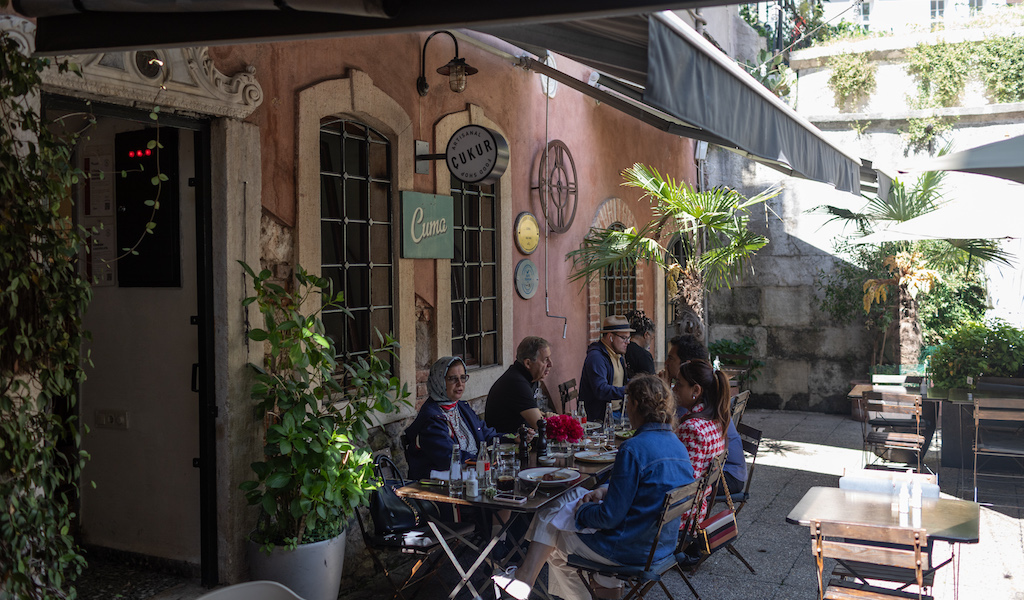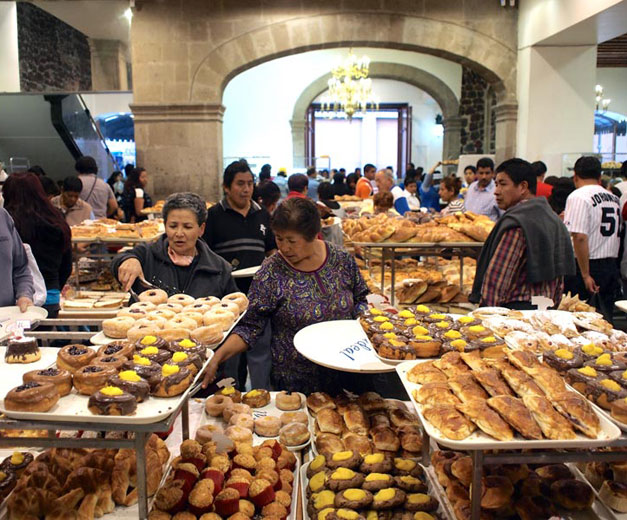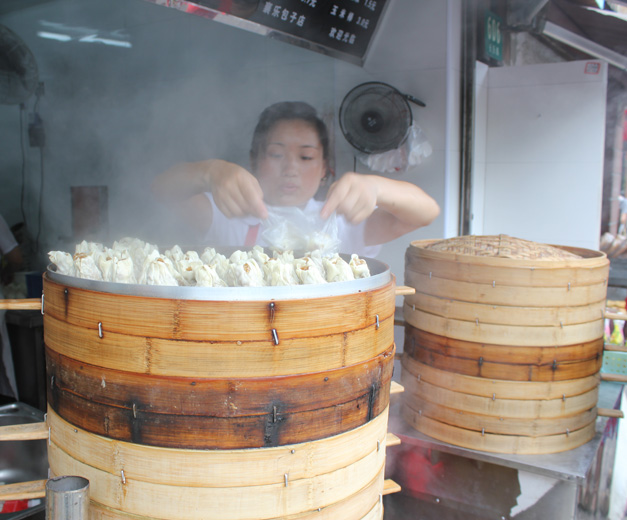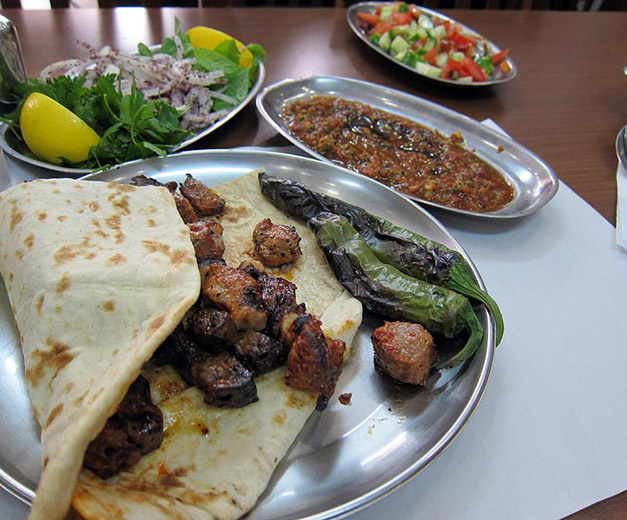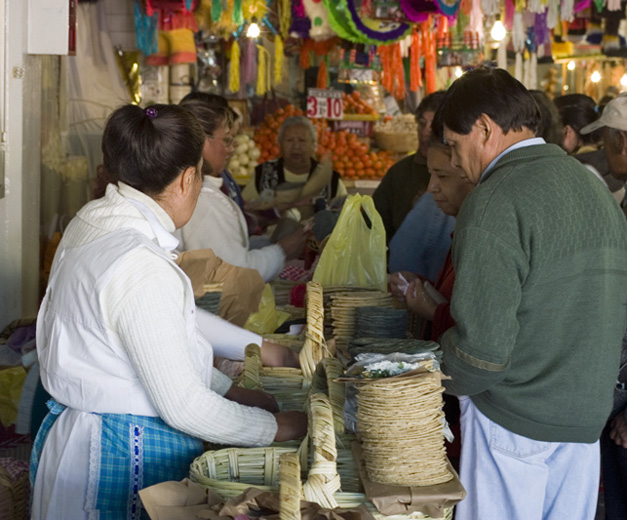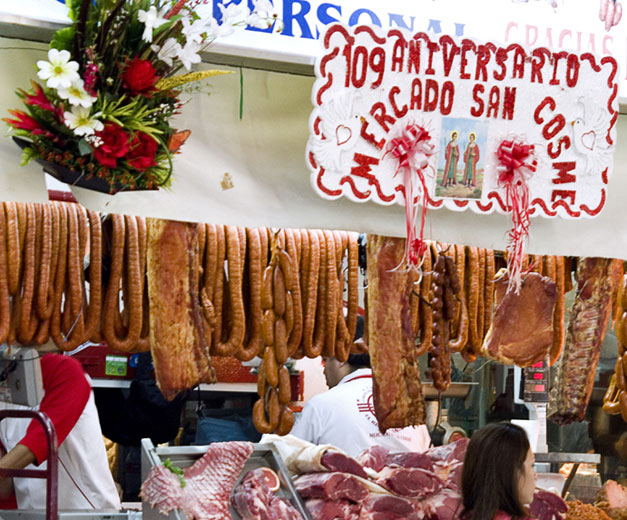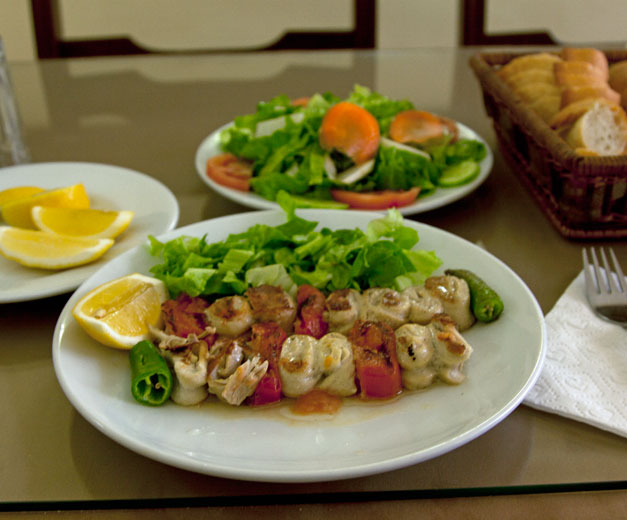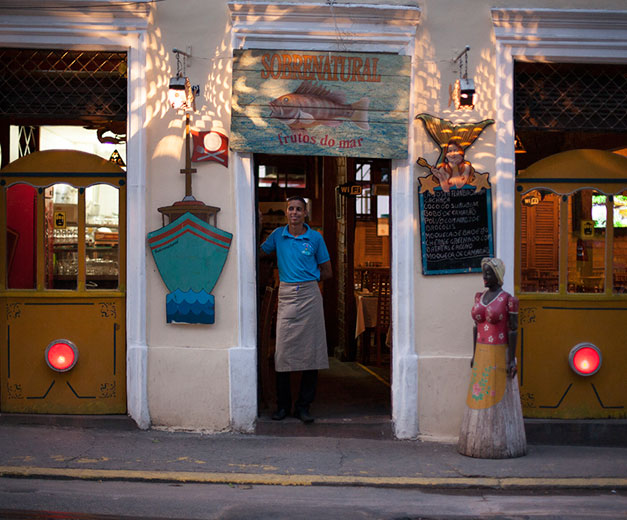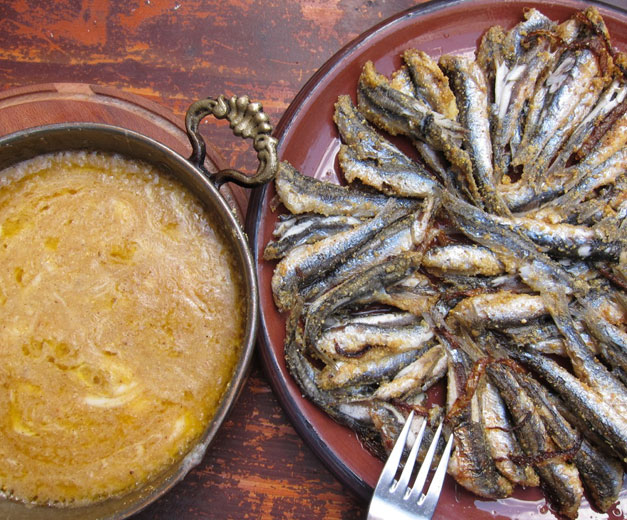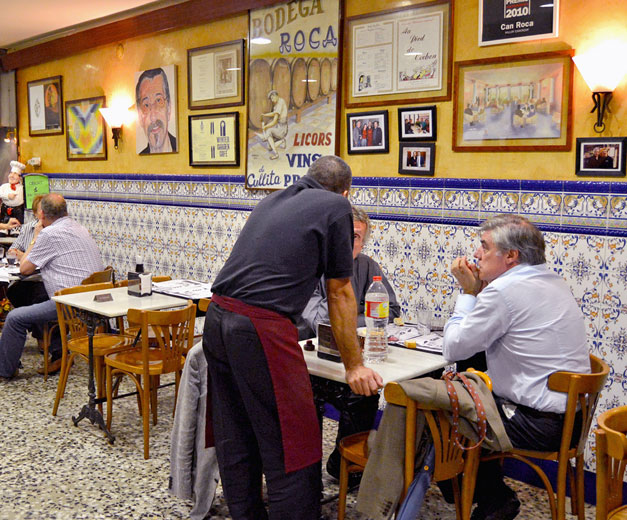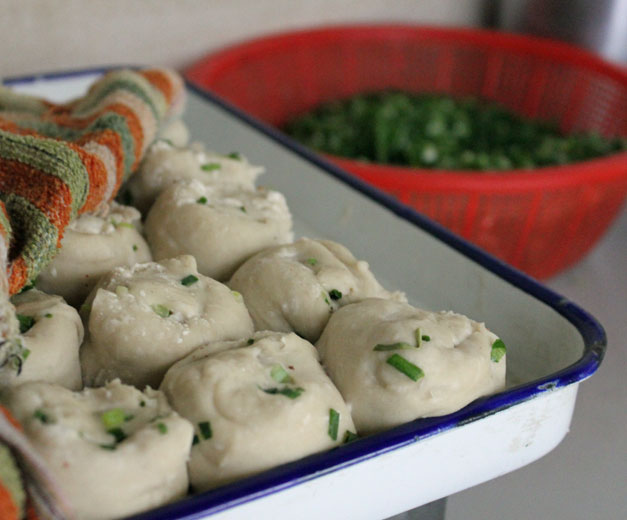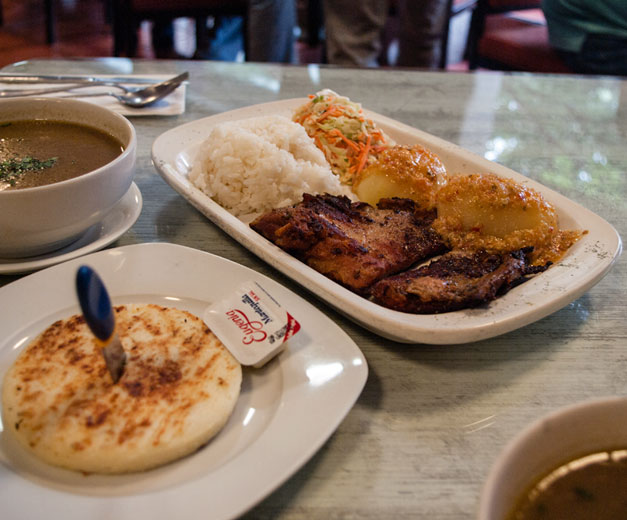We can't find the internet
Attempting to reconnect
Something went wrong!
Hang in there while we get back on track
Search results for
Shanghai
Kuta's Kitchen: Big in China
It’s been more than half a century now since The Beatles formed, and their worldwide popularity continues unabated. In Japan especially, the band’s presence and influence were outsized almost from the beginning, and John Lennon’s marriage to Yoko Ono cemented the band’s place in Japanese culture.
Read moreRio
Espírito Santa: The Amazonian Kitchen
In a country the size of Brazil, you’ll have an easier time finding a carioca who’s been to Disney World than to the Amazon region, so cut off is it by vast forests and pricey airfares from the cosmopolitan southeastern cities of São Paulo and Rio. When we visited Manaus and took a days-long boat trip on the Rio Solimões, we introduced ourselves as American, living in Rio. Locals seemed uninterested in asking the usual litany of questions about America but grilled us on Rio, which they had only seen in evening telenovelas.
Read moreIstanbul
Cuma: A New Breakfast Regime
Editor's note: Our last dispatch for Breakfast Week takes us to a charming spot in Beyoğlu, where followers of Istanbul's two competing schools of breakfast can enjoy their morning meals side by side. Istanbul is a dynamic city, where conditions can change so quickly and completely that it’s easy to forget the way things used to be. The new reality can be so strong and ever-present that the past feels like a hazy dream, if that. But no, this is not an article about Turkish politics. This is an article about Turkish breakfast.
Read moreBarcelona
Can Ros: Put a Fork in It
Fried pig’s ears fortified with garlic and parsley, veal cheek and tongue laced with vinaigrette, hefty veal and pork meatballs, creamy artichoke or eggplant omelets or a hearty bocadillo of marinated tuna, red pepper, anchovies and olives: these esmorzars de forquilla, or “fork breakfasts,” are how a Catalonian might start his day – especially at Can Ros, a tapas-and-bocadillos joint that’s open every day from 7 a.m. until midnight. Office workers might drop by for a coffee at mid-morning, followed by the lunch crowd, which takes over from 2 p.m. to 4 p.m. Dinner, of course, lasts well into the night. It’s breakfast, however, that has made Can Ros most popular among locals.
Read moreAthens
Breakfast in Athens: The Morning Report
Editor's note: We are regret to report that Nixon and Hip Cafe are closed. Editor's note: Our third installment for CB's Breakfast Week takes us to Athens, where we take a look at traditional breakfasts and how globalization is changing the way Greeks eat -- especially on weekend mornings. In Athens, brunch has become big business. Over the last couple of years, locals have fully embraced this foreign import, and numerous venues have sprung up across the city to bring Eggs Benedict and Bloody Marys to hungry Athenians every weekend.
Read moreMexico City
Rise and Shine: A Mexico City Breakfast Primer
Editor's note: It's Breakfast Week at CB, and the second piece in the series takes us to Mexico City for a look at typical morning meals and the best places to find them. Stay tuned for more breakfast dispatches from other CB cities throughout the week. Mexico leads the world in per capita egg consumption, according to the country’s National Poultry Institute. That’s not hard to believe if you’ve ever taken a look at a typical Mexican breakfast; in homes and at restaurants huevos are the first order of the day for many a desayuno. And with all those eggs they eat, Mexicans have come up with a number of ways to dress them up or down. One of the most popular ways to prepare them, for example, is huevos revueltos al gusto, two or three scrambled eggs with an additional ingredient or ingredients, such as ham, chorizo, sausage, vegetables or a la mexicana (onion, chilis and tomato). Huevos can also come divorciados, which are two sunny-side-up eggs, one bathed in green salsa and the other in red; rancheros, or fried and served over corn tortillas and refried beans and bathed in a red or green salsa; al albañil, scrambled and served with a very hot red salsa and fresh cheese; or ahogados, poached in green or red salsa. Most of these egg dishes are served with a side of refried beans, avocado and corn tortillas.
Read moreShanghai
Step Away from the Buffet: A Shanghai Breakfast Primer
Editor's note: It's Breakfast Week here at CB, and to kick off the series, we first head to a street corner in the heart of Shanghai that offers a remarkable variety of breakfast foods. Stay tuned all this week for more morning dispatches from other CB cities. We’re all guilty of indulging in the complimentary hotel breakfast buffet a little too often while traveling. But in Shanghai, the widest array of street food is on full display in the morning hours, as young professionals and retirees alike gather at their favorite stands for a quick bite with friends or on their way to work.
Read moreRio
Casa Paladino Comestíveis: Preservation Society
In a city filled with Technicolor snack bars, Casa Paladino Comestíveis instead looks more like the kind of place where you’d find seedy men smoking cigars in a black-and-white film. Glass cases lining the walls display manila-labeled cachaça and Cuban rum bottles, with an occasional anachronism, like boxed Toddynho chocolate milk, breaking its turn-of-the-century salon aesthetic. Cloudy mirrors, a handwritten menu and a grape-adorned Bacchus sculpture decorate its black carved wooden walls.
Read moreAthens
Magemenos Avlos: Mad Men in Athens
Just a stone’s throw from centrally located Vasileos Konstantinou Avenue, the tree-lined neighborhood in and around Plateia Proskopon (Scouts’ Square) is verdant and full of charm. Wonderful dining options abound here, with new entrants such as the popular Mavro Provato joining a host of beloved older eateries. Among the latter is Magemenos Avlos, a glamorous throwback specializing since 1961 in European cooking, and a favorite meeting place of musicians, poets, actors, politicians and remarkable personalities of the 1960s and ’70s.
Read moreIstanbul
Babo'nun Yeri: Organ Music
Near the Aksaray metro station, set back from a loveless part of Istanbul crossed by wide roads and overpasses, the kebab is flourishing. Over the past few decades, waves of migration have brought a particularly southeast Anatolian flavor to the otherwise drab apartment blocks and government buildings of this part of the Fatih district. Now bright isot peppers are strung up, handwritten signs in Arabic advertise services in barbershop windows, a nargile café is filled with older men smoking and playing cards. Nowhere else in the city is there such a high density of kebab restaurants and most of them are run by families from the southeastern city of Urfa.
Read moreShanghai
Ask CB: Buying Kitchen Supplies in Shanghai?
Dear Culinary Backstreets, I just moved to Shanghai, and while I’m looking forward to investigating all the street food options, I’d love to be able to make dinner at home too and would like to get into Chinese cooking. Where’s the best place to stock up my new kitchen?
Read moreAthens
Vasilopita: A Sweet Tribute to the New Year
Just after the stroke of midnight on New Year’s Eve or on the first day of the New Year, many Greek Orthodox families gather around the table to cut and split the vasilopita, a cake named after St. Basil (Aghios Vasilios), the Greek Santa Claus. The head of the family “crucifies” the cake three times with a knife and then cuts it into triangular pieces. Usually, the first piece is offered to Christ, the second to the Virgin Mary, the third to St. Basil and the fourth to the “house” before family members and friends each receive one. Some may offer a slice to St. Nicholas, the patron of sailors, to the poor, as St. Basil cared for them, or to the family shop or company. The custom of dividing the vasilopita is performed at many events throughout January and even into early February among many associations, agencies and other organizations. Each person wishes the others chronia polla (“many years”) and “Happy New Year” to bless the house and to bring good luck.
Read moreShanghai
Lao Beijing Shuan Guo: Hotpot Hotspot
The hotpot’s storied history stretches back over a millennium in China. The cooking method originated in Mongolia, where legend has it that warriors used their helmets as makeshift pots, boiling strips of horse and lamb meat over campfires to sustain them as they made their way south to breach the Great Wall. As hotpot cooking proliferated, regional variations took their toll on the meal’s simplicity, earning it the nickname of “Chinese fondue” among some Westerners.
Read moreMexico City
Mercado Xochimilco: Get Off the Boat
One of our favorite places in Mexico City is Xochimilco. Like many visitors, when we hear the word “Xochimilco” the first thing that comes to our mind is a relaxing ride aboard a trajinera, or boat, on the waterways of this southern borough. We’ve been to Xochimilco many times before, on family excursions to buy flowers, plants and compost from the local farmers.
Read moreBarcelona
El Passadís del Pep: Simple Pleasures
A hidden culinary sanctuary, El Passadís del Pep may be located in one of the most visited quarters of Barcelona, but it’s out of sight of anyone who isn’t looking for it. Once you go down the long corridor that leads to the restaurant, you don’t need to do anything, and that includes choosing what to eat. From the moment you sit down, the “house” offers you your first bottle of cava, and the celebration of food and life begins. There is no menu and there are no “daily specials,” just whatever Joan Manubens and his team decide to cook that day.
Read moreIstanbul
Best Bites of 2013: Istanbul
Editor’s note: This is the final installment of “Best Bites of 2013,” a roundup of our top culinary experiences over the last year. Be sure to check out the "best bites" in all the other cities CB covers. Breakfast in Erzincan We were strangers in a strange land – eastern Turkey’s Erzincan, to be exact – and Yalçın Kaya welcomed us into his cheese shop with such gracious fervor that it didn’t surprise us to find out that this Anatolian cheesemonger moonlights as an imam.
Read moreAthens
Best Bites of 2013: Athens
Editor’s note: This post is the penultimate installment of “Best Bites of 2013,” a roundup of our top culinary experiences over the last year. Be sure to check out the “Best Bites” from all of the cities Culinary Backstreets covers. To Rodi Tucked into a small corner of a working-class residential suburb, with unimpressive décor reminiscent of a local souvlaki joint, the Armenian-Turkish restaurant To Rodi is further evidence that appearances can be deceiving.
Read moreMexico City
Best Bites of 2013: Mexico City
Editor’s note: This post is the fourth installment of “Best Bites of 2013,” a roundup of our top culinary experiences over the last year. Stay tuned for “Best Bites” from all of the cities Culinary Backstreets covers. Hilaria Gastrobar We visited this restaurant on revitalized Madero Street downtown just a few months after it opened, and we were immediately won over by the food and beer selection.
Read moreRio
Best Bites of 2013: Rio
Editor’s note: This post is the third installment of “Best Bites of 2013,” a roundup of our top culinary experiences over the last year. Stay tuned for “Best Bites” from all of the cities Culinary Backstreets covers. Bar do Adão There are so many good fillings – 65, in fact – for the pastéis, or fried turnovers, at Bar do Adão that we appreciate their diminutive size, which allows us to eat a greater variety in one sitting.
Read moreBarcelona
Best Bites 2013: Barcelona
Editor’s note: This post is the second installment of “Best Bites of 2013,” a roundup of our top culinary experiences over the last year. Stay tuned for “Best Bites” from all of the cities Culinary Backstreets covers. Forn Baluard We started the year off heating our hands near the wood-fired oven at Forn Baluard, one of Barcelona’s top bakeries. It hasn’t been around long, but it has decades of experience in its DNA, as it’s headed up by Anna Bellsolà, a fourth-generation baker.
Read moreShanghai
Best Bites 2013: Shanghai
Editor’s note: This post is the first installment of “Best Bites of 2013,” a roundup of our top culinary experiences over the last year. Stay tuned for “Best Bites” from all of the cities Culinary Backstreets covers. Deng Ji Chuan Cai Culinary bucket lists are some of the best ways to discover our friends’ hidden gems: expat foodies are only willing to give up their proprietary favorites when they’re heading home.
Read moreIstanbul
CB on the Road: In Eastern Turkey's Yogurtlands
Like many other Central Anatolian cities, Erzincan is one of those places with very little there there. The natural setting – on a high plateau and ringed by craggy peaks – is promising, but the town itself feels like it’s been scrubbed clean of all traces of history or local distinctiveness, its streets lined with characterless buildings painted in fading pastels, their ground floors occupied by the same furniture and supermarket chains found in every other city in the Turkish heartland. Erzincan does have one thing going for it, though: it’s the kind of place where you can land at the airport, hop into a waiting taxi and ask your driver to take you to the local cheese sellers’ bazaar, and he’ll take you straight there, no questions asked, as if it’s the most natural request he could get.
Read moreAthens
Culture Clubs: Athens' Top Spots for Greek Yogurt
In a recent New Yorker profile of Turkish entrepreneur Hamdi Ulukaya, founder of Chobani, a wildly successful company that makes Greek-style yogurt in the U.S., we read with great interest about the trip writer Rebecca Mead made to Argos, in the Peloponnese, where renowned cookbook author Diane Kochilas had told Mead she’d had “the best yogurt she had ever tasted.”
Read moreBarcelona
Turrón: Have Yourself a Chewy Little Christmas
Typically eaten at Christmastime in Spain, turrón (a type of nougat) originated centuries ago. Some historians believe it was a sweet paste with nuts eaten by athletes in ancient Rome, while others trace its origins to a more elaborate medieval Arab delicacy that combined various toasted nuts with spices and honey.
Read moreMexico City
La Casona del Sabor: School Lunch
Once considered Mexico City’s next hot neighborhood, Santa María la Ribera, near the city's center and one of its first suburbs, has been slow to deliver on that promise. While neighborhoods just to the south have stolen Santa María’s thunder, it’s finally showing signs of life – one of which is the restaurant/cooking school La Casona del Sabor. Built 140 years ago by a German immigrant couple, the building that houses La Casona features traditional colonial architecture, including a grand entrance that leads into a spacious, landscaped courtyard. Looking out over the courtyard is a colorfully tiled verandah that connects to multiple rooms. Once family quarters, these rooms now serve the culinary school. The school's head chef, Jorge Luiz Alvarez, began the school seven years ago in his nearby apartment, but when space became tight, he took over the house and expanded the business.
Read moreShanghai
Festive Meals on Wheels: Holiday Delivery Roundup
For expats, the holiday season can be a time of mixed emotions. The distance from home can intensify our feelings of nostalgia (and cravings for Mom’s apple pie). On the other hand, we are liberated from the customs that bind us to familiar feasts, and we have the freedom to form new holiday rituals with friends.
Read moreBarcelona
El Tossal: Down from the Mountains
Now that ski season has begun in Catalonia, thousands of Barcelonans make the pilgrimage every weekend to the Pyrenees. But winter sports are not the only draw; this is also the time to enjoy the cooking at masias, traditional farm buildings that have been converted into restaurants.There, the smells of winter stews and dishes made with mushrooms, game, mongetes (beans) and butifarra (a kind of pork sausage) are motivation enough to arrive at the village early and in one piece.
Read moreMexico City
Mercado San Cosme: Treasure Trove
Whenever we explore a neighborhood in the city, we look for the tianguis: local markets that serve as a very important part of life in Mexico. Almost everything needed for a household can be found in their narrow and colorful aisles. Mercado San Cosme is the tianguis in Colonia San Rafael, a beautiful and charming neighborhood that was established in the late 19th century as one of the first formal communities outside of the city center. In the Porfirio Díaz era, San Rafael catered to the wealthy, and the beautiful buildings and façades that still grace the streets there speak to those long-ago days of glory.
Read moreIstanbul
Salep: Pure and Uncut
When we last visited Cemal Bey, he was sitting behind a desk in a small, bare office on the second floor of a decrepit building near the Egyptian Bazaar in the city’s old quarter (he has since moved). Three large burlap sacks filled with what look like jumbo-sized yellow raisins are all that adorn the room. That and a fax machine. The window behind him frames one of Istanbul’s many transfixing cityscapes – the Golden Horn stretching out under the Galata Bridge where it meets the Bosphorus and the Marmara Sea, departing ferries churning the water white – but Cemal keeps his eye on a fax that’s coming in.
Read moreAthens
Valentina: From Russia with Love
As the weather gets colder and the nights longer, we seek out food that will warm us from the inside out. Although the usual comfort food we enjoy is souvlaki, there are times when warming food from a colder clime is just what we need. And that’s when we head to Valentina.
Read moreIstanbul
İstiridye Balık Lokantası: The Business of Lunch
Editor’s note: We regret to report that İstiridye Balık Lokantası has closed. These days, writing about Istanbul’s old-school restaurants can be heartbreaking work. No sooner do we find out about a classic lunch spot than it turns out the place is about to be closed down to make way for yet another development project. Meanwhile, Istanbul’s relentless drive to modernize and “clean up” its streets has meant there is less and less room for traditional food vendors to operate. We weren’t surprised to learn that one of our favorite street food sellers, the bespectacled man who provided freshly peeled cucumbers by the Galata Tower, recently gave up his iconic perch after being relentlessly squeezed by the municipal authorities.
Read moreBarcelona
Catalonia's White Wines: The Whole Spectrum
When we think of white wine in Catalonia, we think of its seemingly endless possibilities. Production of whites here has a 2,000-year-old history. The wide-ranging diversity in the area’s Mediterranean climate and calcareous soils, from the mountains to the sea, and the combination of old grape varieties and newly introduced “foreigners” with traditional and experimental methods of production make for innumerable styles and no taboos. Who knew white was a color with so many variations? The traditional Catalan grape varieties used to make white wine are mainly macabeo, xarel-lo, parellada and garnatxa blanca, but this area of Spain has the largest number of white grapes included in all its protected appellations (D.O.). Where other Spanish D.O.s usually are deeply defined by one or a few varieties, in the Catalunya D.O. there are more than 16 allowed – 35 counting the reds. In fact, this umbrella appellation, which covers wines that do not fall under the 10 subregion designations (Montsant, Penedès, etc.), was created to allow the use of all the grapes of the other Catalan designations in the entire area. It implicitly gives freedom to Catalan winemakers to express more than the old narrower conceptions of terroir and opens the doors to experimentation.
Read moreAthens
All Natural: A Shopper's Guide to Greek Wild Herbs
We’ve talked before about Greek coffee, and it’s true that going out for coffee is one of Athenians’ favorite pastimes, but there are plenty of Greeks who prefer tea or infusions. And in fact, the practice of gathering wild herbs has a history that stretches all the way back into antiquity. References to Mediterranean flora are found everywhere in history, from Egypt to Asia Minor and from Homer to the ancient Greek philosophers’ texts. Take, for instance, Hippocrates, the so-called father of medicine, who focused on the healing properties of plants and actually recorded about 400 species of herbs and their known uses in the 5th century BCE. That era saw a heavy trade in herbs between the Mediterranean and the East.
Read moreShanghai
Ask CB: Chinese Dining Etiquette?
Dear Culinary Backstreets,I often have to dine with Chinese coworkers at banquets and want to make sure I am not offending anyone. Are there certain dining customs I should adhere to? China’s dining etiquette is more flexible and forgiving than that of other Asian cultures – like Japan, for instance – but there are a few rules you should know. Most are nonverbal cues that demonstrate respect, especially at work or government banquets.
Read moreRio
Sobrenatural: Samba and Seafood
With 4,500 miles of coastline, the world’s largest river by volume (the Amazon), more than 10,000 miles of waterways and the largest amount of fresh water on the planet, Brazil suffers from a certain gastronomical misperception. Yes, this is a country that loves beef, prominently on display in popular Brazilian churrascarias.
Read moreShanghai
Pyongyang: Northern Exposure
North Korean cuisine is about as mysterious as it gets. Few travelers have ever actually been to the reclusive country, and news reports are more often about high-profile rescues and the dire food security situation than its national cuisine. Thanks to 10 North Korean restaurants in Beijing and 50 others scattered around Southeast Asia, those living in the Far East have plenty of opportunity to glimpse the country’s dining scene. Shanghai is home to seven branches of the Pyongyang restaurant chain, and food is only part of the draw. With a nightly show around 7:30 p.m., the song and dance numbers put on by the double-duty waitresses supposedly allow for a rare glimpse inside the traditional culture.
Read moreAthens
Manas Kouzina Kouzina: Mama's Kitchen (Minus Mama)
Update: This spot is sadly no longer open. At first you’re puzzled. What a strange name. Why not just call it Manas Kouzina, Mother’s Kitchen, and be done with it? Well, like everything connected with this new Athenian eatery, which opened at the end of August opposite the big butter-colored church dedicated to St. Irene (Agia Eirini) on Aiolou Street, the name was given tremendous thought.
Read moreIstanbul
Hanegah: Little Fish, Big City
Editor’s note: Sadly, it appears that due to the neighbors no longer wanting to be surrounded by fish fry odors, this restaurant is no longer serving hamsi. We will update if things change. Around the time that hamsi, our favorite little fish, appear in the markets of Istanbul in late fall we become restless for the Black Sea-style cooking we’ve been missing since the previous season. Hamsi (fresh anchovies) are not the only thing to eat in a Black Sea restaurant, but eating in one that doesn’t have hamsi sometimes feels like sitting down for a meal in a BBQ joint that only serves coleslaw.
Read moreRio
Gracioso: Port of Call
Rio’s Port Zone is undergoing a major facelift, and whether that will nicely polish its tired face or look like a botched Botox job remains to be seen. The port is the heart of Rio Antigo and particularly central to Afro-Brazilian history.It’s home to Rio’s first favela (squatter settlement), called Providência, which was originally populated in 1897 by veterans of the War of Canudos who were told the government would provide housing when they returned to Rio and found those promises to be delayed and elusive. At this port, up to an estimated half million slaves walked in from Brazil’s shores to then be sold in the port’s slave market, treated in a hospital if they were sick or buried if they died after arrival in Gamboa, where a fascinating makeshift museum called the Cemitério dos Pretos Novos offers a view of the human bones a homeowner found while digging on her property.
Read moreBarcelona
Vell Poblenou: The Rice Stuff
[Editor's note: We're sorry to report that Vell Poblenou has closed.] When people think of rice and Spain, they think of paella. In Barcelona there are hundreds of places to eat paella. And every Thursday you can find it on the menú del día at most restaurants across the city. There’s more to Spanish rice dishes than just paella, though. The word “paella” didn’t even appear until the 18th century; recipe books from the Middle Ages talk only of rice, and particularly the Valencian and Catalan kinds. In fact, “paella” originally referred to the pan used to cook the grain, but eventually came to describe the dish as we know it: rice prepared so that the water or broth completely evaporates and sometimes is left with a toasted layer on the bottom.
Read moreIstanbul
Asuman: East of the Border
Editor's note: Culinary Backstreets' Migrant Kitchen: Taste of Iran event took place in Istanbul on Monday, and to mark the occasion, we're featuring this review of one of Istanbul's few Iranian restaurants. Considering the fact that Iran is a next-door neighbor to Turkey and that so many Iranians call Istanbul home, we’ve always found it more than a bit baffling that there are hardly any Iranian restaurants in the city. Imagine New York with all but a handful of Mexican restaurants? The one Iranian restaurant in town that we did know about – a tourist-oriented place with an in-house musician who played “Hava Nagila” on his zither – mercifully closed down years ago.
Read moreShanghai
Roast Duck: Chopstick Lickin' Good
The Chinese have appreciated the finer qualities of roast duck for millennia, and in that time, they’ve refined their cooking techniques into a virtual art form. The first mention of roast duck (烤鸭, kǎoyā) dates back to the Northern and Southern dynasties (A.D. 420–589). By the Yuan Dynasty (1206-1368), the tawny bird was gracing the tables of mandarins and emperors in then-capital Nanjing, and imperial kitchen inspector Hu Sihui mentioned it in The Complete Recipes for Dishes and Beverages, published in 1330, along with a record of how the duck was cooked.
Read moreAthens
Taxidevontas: Fisherman's Friend
In Piraeus there is a tacit agreement among locals to keep treasured taverns and restaurants hidden, lest they be overrun by the tourists arriving on the cruise ships that dock in town. This is particularly true of Keratsini, a neighborhood on the outskirts of the port city. In 1922, Keratsini became home to Greek refugees driven out of Smyrna, the coast of the Sea of Marmara and Constantinople during fighting between Greece and the nascent Turkish state. At first, these immigrants were treated poorly and suffered poverty and hardships, but eventually they became a vital part of the Greek population.
Read moreBarcelona
Taverna Can Roca: Gustatory Eye Openers
Editor’s note: We regret to report that Taverna Can Roca has closed. In the neighborhood of Sant Andreu we encounter very few city visitors wandering the cobbled streets or peering at the 19th-century two-story houses that pepper this district. Through the doors of Taverna Can Roca, we find even fewer. This is a place that can be considered muy del barrio.
Read moreShanghai
A Po's Cong You Bing: Afternoon Delight
Here at CB Shanghai, we’ve already confessed our undying affection for the scallion oil pancakes (葱油饼, cōngyóubǐng) at A Da. Mr. Wu’s are so beautifully crafted that they take on the aura of art with their precision and flair, but we’re also a little in love with the slapdash, unconventional version fried up by an elderly couple at A Po, just a couple of blocks away.
Read moreIstanbul
Hamsi: Every Which Way
As a chill sets in and heavy clouds roll over Istanbul, turning the Bosphorus battleship gray, we say goodbye to the luscious strawberries and blood-red tomatoes in the market. Fall marks the start of hamsi season, a time when small anchovies fill the nets of fishing boats on the Black Sea coast, squirming their way – with all of the country’s anticipation – onto grills and into pans and ovens throughout Turkey. The colder and rainier it gets, the fatter and cheaper the hamsi become.
Read moreAthens
New Wave Retsina: A Maligned Wine's Comeback
For too long retsina has been thought of as a cheap, oxidized, overly pungent bad wine made from mediocre grapes, its poor quality disguised by an overdose of resin and exacerbated by being stored in questionable conditions in the backyards of seaside tavernas. To say the wine has an image problem is an understatement – but that may be changing. Regardless of its reputation, retsina is a true Greek original. It dates back to the Ancient Greeks, who would coat the interiors of their otherwise porous earthenware amphorae with resin to make their wine storage airtight. Wine drinkers grew to like the taste, and winemakers consequently began adding pine resin to grape must during fermentation.
Read moreShanghai
Lao Shaoxing Doujiang: All-Night Breakfast
In Shanghai, a pretty surefire way to tell whether a dining establishment deserves your attention or not is by the presence of a line in front of it. (A corollary might be that the amount of attention the place deserves is commensurate with the size of the line.) Lao Shaoxing Doujiang passes the test. This ramshackle stand in the Huangpu district serves traditional breakfast foods all night long. Until recently, the stand was run by a granny in her nineties who would ladle out bowls of hot soy milk (豆浆, dòujiāng) into the wee hours of the morning. She retired this year, but her less-than-friendly son has taken over, and the buzz remains (as does the inevitable line).
Read moreMexico City
La Ciénaga: From South of the Border
Immigration between the U.S. and Mexico has long been thought of as a one-way phenomenon, but global economic upheaval and other factors have made the neighbor to the south the new Land of Opportunity. As a recent New York Times article put it, for the first time “more Americans have been added to the population of Mexico over the past few years than Mexicans have been added to the population of the United States.” Nowhere is this more apparent than in Mexico City, where immigrants come not just from the U.S. or other parts of Mexico, but also Argentina, Spain, Korea – everywhere, really. And these immigrants have brought with them a new world of excellent dining options.
Read more

